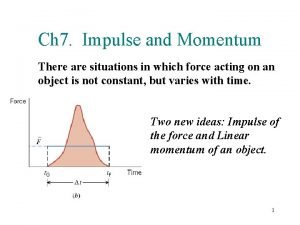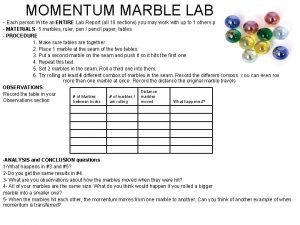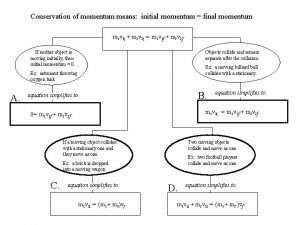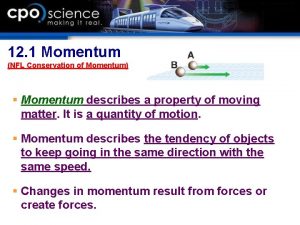Conservation of Momentum The total momentum of an








- Slides: 8

Conservation of Momentum ▶ The total momentum of an isolated or closed system (no external forces) remains constant. Total Initial momentum = Total Final Momentum Two Object Conservation of Momentum (For Objects 1 and 2):

Conceptual Example Two students (m 1 = m and m 2 = 2 m ) are in rolling chairs. Beginning from rest, they push off away from each other. Student 1 moves to the right with a positive velocity. A. What was the initial momentum of the two students? B. What can we infer about the velocity of student 2 after they push off of each other?

Example 4: Chemistry Throwback An atomic nucleus (mass = 222. 0 u) is initially moving at 420. 0 m/s. This nucleus emits an alpha particle (mass = 4. 000 u) in the same direction as its velocity. The new atomic nucleus slows to 350. 0 m/s. What is the velocity of the alpha particle? (Note: u is the symbol for atomic mass unit, which is a measurement derived from the kilogram. This problem may be evaluated without converting the mass of the particles).

Conservation of Momentum Additional Example Total momentum of all objects before = Total momentum of all objects after A full grocery cart (mass = 25 kg) moving with a positive velocity of 10 m/s collides with an empty one (mass = 8 kg) also moving in a positive direction with a velocity of 3 m/s. After the collision, the full cart continues to move forward, but only with a positive velocity of 1. 2 m/s. What is the velocity of the empty cart after the collision?

Collisions!! ▶ ▶ Three different kinds of collisions IMPORTANT: In ALL collisions, momentum is conserved. ▶ Elastic Collisions ▶ Inelastic Collisions ▶ Total Inelastic Collisions

Collisions! Elastic ▶ Perfect rebound, no energy loss ▶ ▶ Inelastic ▶ Some energy loss Momentum conserved ▶ Momentum conserved KE conserved ▶ ▶ KEo = KEf KE NOT conserved ▶ Total Inelastic Objects are stuck together after collision ▶ Momentum conserved ▶ KE NOT conserved

Collision Summary Collision Elastic Collision Inelastic Collision Total Inelastic Collision Kinetic Energy Conserved Momentum Conserved YES NO YES

Example 5 – Elastic Collision A 4. 00 kg block is moving to the right with a velocity of 10. 0 m/s and collides with a stationary second block (mass = 6. 00 kg) in an elastic collision. After the collision, the 6. 00 kg block was seen moving to the right with a velocity of 8. 00 m/s. What is the final velocity for the 4. 00 kg block? *Solve using both conservation of momentum as well as conservation of kinetic energy.














